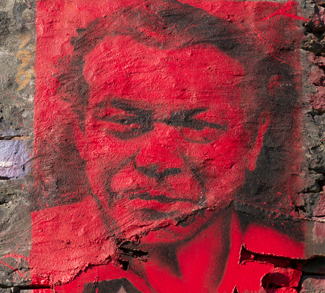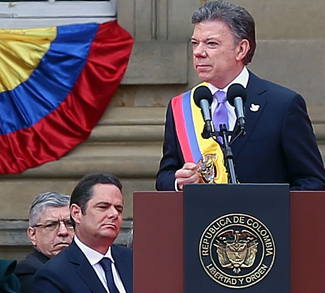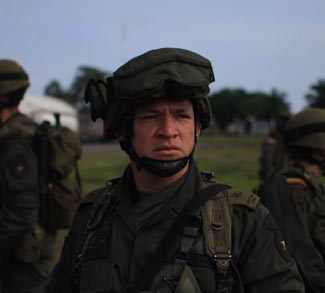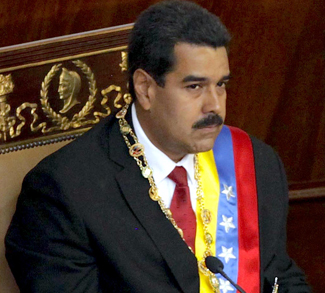Colombia is on the verge of concluding a historic peace deal with the left-wing rebel group FARC, in an agreement which would signal an end to the world’s longest-running continuous conflict. Since hostilities began in 1948, many previous negotiation attempts have failed. However, the current peace talks in the Cuban capital of Havana have been progressing steadily since 2012, with both sides having overcome seemingly insurmountable differences to reach the stage where a final accord is scheduled to be signed by the end of March.
The talks began in October 2012, with five key issues on the agenda: rural development and land reform, guarantees on the exercise of political opposition and citizen participation, the end of armed conflict, an agreement to tackle drug trafficking, and agreements on the rights of victims and the establishment of a post-war judicial process. After initial scepticism, there has been a growing willingness on both sides to compromise in order to bring an end to almost 70 years of turmoil which has plagued Colombian society. Agreement has now been reached on even the most contested issues, with just a few minor details left to be finalised before the historic accord is signed.
To analyse the deal in context, it is important to go back to the roots of the conflict. In 1948, the violence began amid tensions over the issue of land rights, and was further ignited by the assassination of Jorge Eliecier Gatian, the liberal reformist candidate in that year’s election. The conflict reflected Colombia’s segregated society, characterized by wide inequalities between the rich and poor. Two major groups of left-wing insurgents developed: the Revolutionary Armed Forces of Colombia (FARC) and the National Liberation Army (ELN). At the other end of the political spectrum, right-wing paramilitary groups emerged, taking the form of vigilante groups set up by local landowners to defend themselves against the rebels. The main group on this side was the United Self-Defence Forces of Colombia (AUC), which has now been officially de-mobilized.
The conflict quickly developed into a complex four-sided civil war involving FARC and other leftist groups, right-wing paramilitaries, drug cartels, and the Colombian government’s armed forces. In the context of weak state institutions and a lack of control over rural areas, the situation evolved into a pervasive war with no end in sight. Land ownership remained a core issue throughout, and all sides fought for territory, terrorizing local populations in the process. The conflict was further complicated by the growth of powerful drug cartels, which have thrived in the atmosphere of instability. The most infamous of these was Pablo Escobar’s Medellin Cartel, which waged war against the state and wreaked havoc across the country.
Once the peace agreement has been formally ratified, the challenge of moving on from decades of conflict will be a huge and delicate process, with the issue of justice for victims being especially important and sensitive.
The effects of the war on Colombia’s population have been dire, with at least 5 million people internally displaced, and an estimated 200,000 killed since the conflict began. Despite the absence of reliable figures and attempts by all sides to obscure the truth, both the government and paramilitaries, along with FARC and the drug cartels, have been accused of massacres, disappearances, torture, assassinations, kidnappings, and extortion.
Over the last two decades, criminal gangs have played an increasingly prominent role, whilst the cocaine trade has been a major driver of the conflict, providing millions of dollars in funding for armed groups. Former President Alvaro Uribe, in power from 2006-2010, pursued a hard-line stance against the rebels; whilst his successor Juan Manuel Santos has been a key figure behind the peace talks, vowing to end the conflict when elected in 2010. In recent years, the conflict has become more low-intensity in nature, evidenced by a marked decrease in the level of violent crime and kidnappings. FARC’s influence across the country has reduced significantly, however they still operate across vast rural areas and control swathes of territory where state presence is especially weak.
In the mid-2000s, there was a drive to disarm the paramilitary groups as a first step in ending the conflict, and more than 31,000 fighters handed over their weapons. However, this has been criticized by human rights groups as constituting a widespread amnesty for government-backed forces, sparking concerns over a lack of due process and justice for victims of state abuses.
As the peace talks have progressed over the past four years, they have been viewed by many in Colombia as constituting a ‘last chance’ for peace. At the moment, a settlement looks likely to be reached as FARC still has considerable political and ideological elements which make negotiation possible. However, it is feared that if the current round of peace talks were to fail, then future generations of rebels would grow up knowing only war, making future negotiations all the more difficult.
The achievements of the peace deal appear to be remarkable and unprecedented in scope when compared with settlements of previous civil conflicts around the world. Each side has worked to overcome huge differences over how a post-war transitional justice process would work. It has been agreed that a special jurisdiction will establish a tribunal and justice chambers to investigate and prosecute war crimes, with Columbian judges controlling the proceedings, backed by a small number of international observers. The judicial process is described as a ‘comprehensive system for truth, justice, reparation, and non-repetition,’ with those willing to co-operate and accept responsibility for crimes being eligible for ‘alternative sanctions’: instead of jail terms, those who accept responsibility will be sentenced to community work for up to 8 years. However, those who fail to co-operate or accept responsibility, could be sentenced to up to 20 years in jail if found guilty. Most crucially, the process will be subjected to all sides in the conflict: rebels, paramilitaries and state agents; whilst drug-related offences will be treated separately in line with Colombia’s criminal law.
To ensure the process runs smoothly, President Santos has asked the US government to remove FARC from its list of terrorist organizations, and has requested that arrest warrants for members of FARC’s leadership are suspended. Colombia has been a staunch ally of the U.S. in South America, whilst since 2000, the U.S. has granted Bogota more than $10 billion in counter-insurgency and counter-narcotics aid. The United States also has extra interest, as 90% of cocaine on US streets is smuggled from Colombia, therefore an end to the conflict would allow more attention to be paid to the ‘war on drugs’ in the South American country, with the U.S. providing training to law enforcement authorities and intelligence to help combat drug traffickers.
At the joint request of President Santos and FARC, the UN has unanimously adopted a resolution to establish a political mission in Colombia, after the final accord has been signed. This would last for a minimum of 12 months, and would consist of a small number of un-armed international observers, to monitor and verify the bilateral ceasefire and cessation of hostilities.
Once the peace agreement has been formally ratified, the challenge of moving on from decades of conflict will be a huge and delicate process, with the issue of justice for victims being especially important and sensitive. Rather than just constituting the de-mobilization and disarming of armed groups, the end to the conflict also highlights the need for radical and deep transformation of Colombia’s economic and social structures, which will be necessary to ensure that the patterns of division, inequalities, and economic underdevelopment which created the conditions for the conflict to emerge in the first place, are not repeated. Other rebel groups such as the ELN could remain an obstacle to peace, as could the hard-right of the political spectrum. An additional worry is that war has become a ‘way of life’ for many in Colombia, which could make the cycles of violence and crime increasingly difficult to break. The hope now is that many former rebels will engage in politics, with FARC taking its place alongside other left-wing groups in elections.
The signing of the final accord in the peace process would be a historic moment for Colombia, enabling it to look towards the future with a renewed sense of hope and optimism. The country has already stabilized in recent years as the intensity of the conflict has waned. It is now taking its place as one of the world’s fastest-growing emerging markets, offering opportunities and the chance of prosperity for future generations. During the last four years of talks, Colombia has come a long way, and now that an agreement is on the horizon, the difficult task of re-building a fractured society can begin.




